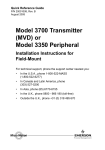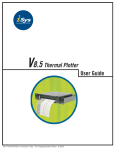Download Baxall DVS24A Operating instructions
Transcript
Deutsch English Français Please read this in conjunction with the Installation Instructions Cette note doit être lue et jointe aux instructions d'installation. Bitte zusammen mit den Installationsanweisungen lesen. SECURITE ET COMPATIBILITE ELECTROMAGNETIQUE PRODUKTSICHERHEIT UND ELEKTROMAGNETISCHE VERTRÄGLICHKEIT (EMV) PRODUCT SAFETY AND ELECTROMAGNETIC COMPATIBILITY (EMC) This product is intended for use in general purpose CCTV applications in a residential, commercial or light industrial EMC environment. Refer to your agent before installing or using the product in medical and/or intrinsically safe applications or in an industrial EMC environment. WARNING : This is a Class A product. In a domestic environment this product may cause radio interference in which case the user may be required to take adequate measures. The product must be installed in accordance with good installation practice to enable the product to function as intended and to prevent problems. Refer to your agent for installation guidance. Contact your agent to obtain a specification defining the acceptable levels of product degradation with regard to EMC immunity. MANUFACTURER’S DECLARATION OF CONFORMANCE The manufacturer declares that the product supplied with this document is compliant with the essential protection requirements of the EMC directive 89/336 and the Low Voltage Directive LVD 73/23 EEC. Conforming to the requirements of standards EN 55022 for emissions, IEC801 parts 2, 3 and 4 for immunity and BS415 superseded by EN60950 for Electrical Equipment safety. Issue 1 Ce produit est destiné à être utilisé pour les applications générales de télévision en circuit fermé dans des environnements résidentiels, commerciaux ou d'industries légères à compatibilité électromagnétique. Dieses Produkt ist für den Einsatz in allgemeinen CCTVAnwendungen in Wohn-, Geschäfts- oder leichtindustriellen Umgebungen ausgelegt. Prendre conseil auprès du revendeur avant d'installer ou utiliser le produit pour des applications médicales et/ou à sécurité intrinsèque ou dans un environnement industriel dans lesquels des précautions doivent être prises dans le domaine des interférences radioélectriques. Wenden Sie sich bitte an Ihre Vertretung, bevor Sie das Produkt in medizinischen und/oder eigensicheren Anwendungen oder in einer industriellen EMV-Umgebung installieren. ATTENTION : Ce produit est rangé en Classe A. Dans un environnement domestique il peut provoquer des interférences radioélectriques. Dans ce cas, l'utilisateur pourra être amené à prendre des mesures appropriées. WARNUNG : Dies ist ein Produkt der Klasse A. In einer Wohnumgebung kann dieses Produkt Funkstörungen verursachen; in diesem Fall wird der Benutzer möglicherweise geeignete Maßnahmen ergreifen müssen. L'installation doit se faire en respectant les règles de l’art afin de permettre le bon fonctionnement du produit et empêcher que d’éventuels problèmes surgissent. Pour obtenir des conseils sur l'installation, s’adresser au revendeur. Das Produkt muß gemäß guten Installationsverfahren installiert werden, damit es vorschriftsmäßig funktionieren kann, und um Probleme zu verhindern. Richtlinien für die Installation erhalten Sie von Ihrer Vertretung. Pour obtenir une spécification définissant les niveaux acceptables de dégradation du produit en relation avec la compatibilité électromagnétique, s’adresser au revendeur. Eine Spezifikation, die das akzeptable Ausmaß der Produktdegradation hinsichtlich EMV-Störfestigkeit festlegt, können Sie von Ihrer Vertretung anfordern. DECLARATION DE CONFORMITE PAR LE FABRICANT Le fabricant déclare que le produit fourni est conforme aux prescriptions de la directive 89/336 sur la compatibilité électromagnétique et de la directive LVD 73/23 sur la basse tension. Il est également conforme aux normes EN 55022 sur les émissions, IEC801 sections 2, 3 et 4 sur la compatibilité et BS415 remplacée par la norme EN60950 relative à la sécurité des équipements électriques. HBEMC/LVD -A-1 KONFORMITÄTSERKLÄRUNG DES HERSTELLERS Der Hersteller erklärt hiermit, daß das mit diesem Handbuch gelieferte Produkt die grundlegenden Schutzanforderungen der EMV-Vorschrift 89/336 und der Niederspannungsverordnung LVD 73/23 EEC erfüllt. Entspricht den Anforderungen der Normen EN 55022 für Emissionen, IEC801, Teil 2, 3 und 4, für Störfestigkeit und BS415, ersetz durch EN60950 für die Sicherheit von Elektrogeräten. Issue 1 : 1/97 DVS24 DVS28 Installation and Operating Instructions English Dual Monitor Desk Video Switcher 1 – 10 Read these instructions first! Manuel d’installation et d’utilisation Français Console de commutation pour deux écrans 11 – 20 Veuillez lire ces instructions avant de commencer! Installations- und Betriebsanweisungen Tisch-Videoumschalter mit zwei Monitoren Bitte zuerst diese Anweisungen lesen! Deutsch 21 – 31 BLANK Page 2 English For Safety Please follow these instructions as you install your DVS2 and have them available during the life-time of the DVS2. If you have any problems contact your supplier or telephone Baxall’s Technical Support Department on +44 (0)161 406 6611. WARNING: INSTALLATION IS ONLY TO BE CARRIED OUT BY SUITABLY QUALIFIED AND EXPERIENCED PERSONNEL WARNING: ONLY USE THE DVS2 WITH THE CLASS 2 POWER SUPPLY PROVIDED AND DO NOT ATTEMPT TO USE THE POWER SUPPLY FOR ANY OTHER PURPOSE The DVS2 is designed for use in general purpose CCTV applications and must not be used for intrinsically safe or medical applications. Do not exceed the voltage and temperature limits given in the specifications. Only use the DVS2 in a clean, dry, dust-free environment. Unpacking Keep your packaging for use if your DVS2 is stored for a time or needs to be returned for whatever reason. The packaging should contain:» The switcher, either:- the DVS24 with 6 keys, or the DVS28 with 10 keys. » A mains-socket mounting +12V DC power supply (class 2) » These instructions If any of the items are missing or damaged then inform the suppliers and carriers immediately, and do not attempt to use your DVS2. English Page 3 The DVS2 Your DVS2 takes either 4 or 8 camera inputs which it switches to two monitors. You can select cameras by pressing the relevant numbered key. There is also an AUTO key which starts an automatic sequence on the current monitor. This sequence displays all the cameras in numerical order and automatically skips any unused inputs. You can sequence both monitors at the same time, with each displaying its own sequence. The time spent on each camera in a sequence is called the dwell-time, this can be varied from 1 to 60 seconds. On the main monitor you can change the dwell-time for each camera separately, however on the spot monitor the same dwell-time applies to all cameras in the sequence. This is called a global dwell time. You can also link the DVS28 to 8 alarm inputs (the DVS24 to 4) by using it with the AL8. The available response options are described later in these instructions. Figure 1. A Typical switcher Arrangement (DVS28) Page 4 English Connecting your DVS2 Make all the video connections using 75ohm coaxial cable with BNC connectors on each end. When you are ready to connect your DVS2, refer to figure 2 and follow the instructions given below:» Connect a cable from the connector labelled MAIN to your monitor or VCR. » Connect cables from the cameras to the numbered video-input BNCs. » Plug the jack-plug from the 12V DC power supply into the jack-socket marked 12V DC. » Plug the power supply into a suitable mains power outlet. » Switch on the cameras, monitor and DVS2 (at the mains power outlet). 8 7 6 5 4 3 2 1 MAIN SPOT ALARM 12V DC Earth Terminal Figure 2. Rear Panel Connections Note: We have provided a supplementary earth terminal on the rear panel, please ask Baxall Technical Support if you need further information. Switching On the Power When you switch the power on, your DVS2 may start by displaying a sequence or a single camera. If it cannot find any camera inputs then it scans rapidly through the camera selection LEDs but does not display a picture. English Page 5 Operating Your DVS To select a camera on the MAIN monitor ... simply press a numbered key. To select a camera on the SPOT monitor ... press and hold the SPOT key and press a numbered key. To start the sequence on the MAIN monitor ... press and release <AUTO>. To stop the sequence on the MAIN monitor ... press and release a numbered key. To start the sequence on the SPOT monitor ... press and hold <SPOT> press and release <AUTO>. To stop the sequence on the SPOT monitor ... press and hold <SPOT> press and release a numbered key. To set a dwell-time on the MAIN monitor ... select the camera you want to change, press and hold <AUTO>. The dwell-time for the current camera is displayed on the main monitor in seconds. Use <1> to decrease the dwell-time and <2> to increase it, when you are satisfied release <AUTO>. Repeat this for all the cameras you need to change. To set the global dwell-time on the SPOT monitor ... Press and hold <SPOT> and <AUTO>. The dwell-time is displayed on the main monitor in seconds. Use <1> to decrease and <2> to increase the global dwell-time, when you are satisfied release <AUTO> then <SPOT>. NOTE: Switching off the power does not erase any settings. To position the caption on the screen ... Remove the power plug from the back of your DVS2. Press and hold <AUTO> and re-insert the power plug. Keep <AUTO> held throughout this procedure. Page 6 English The caption should now be displaying the model number and software version. Use <1> to move the caption up and <2> to move it down. Press <4> and the display changes to the software date. Use <1> to move the caption left and <2> to move it right. Release <AUTO>. To display the software version ... follow the instructions for positioning a caption on the screen (above.) To RESET your DVS2 to factory defaults ... Remove the power plug from the back of your DVS2. Press and hold <AUTO> and <SPOT> re-insert the power plug, wait for 3 seconds then release <AUTO> and <SPOT>. Using the DVS2 with Alarms The AL8 has 8 alarm inputs, its function is to tell the DVS2 which o f the alarms are active. The DVS2 assumes that alarm 1 = camera 1, alarm 2 = camera 2 and so on. When only one alarm is active the DVS2 shows the alarmed-camera on the main monitor. If two or more alarms are active it can either: • only display the most recent alarmed camera or, • introduce the alarmed camera into a special sequence with a 2 second dwell-time. Then, once the alarms are all cleared it can either: • hold the last alarmed camera on the main monitor, • start the normal sequence on the main monitor or, • return to the settings it had before the first alarm. A flashing LED indicates that the corresponding alarm is active or has been active. Press the numbered key to cancel this once the alarm is cleared. English Page 7 To Install the AL8 Firstly, follow the instructions supplied with the AL8, then set the alarm options on your DVS2 To set the alarm options on the DVS2 ... Remove the power plug from the back of your DVS2. Press and hold <SPOT> and re-insert the power plug. Press the numbered keys 1 to 3 to toggle the options on and off (an asterisk represents on). The options are as follows:Option 1 : start the normal sequence on the main monitor once all the alarms are cleared. Option 2 : return the MAIN monitor to its original settings once all the alarms are cleared. Option 3 : Sequence the active alarms on the MAIN monitor. With Options 1 and 2 OFF : your DVS2 holds the last alarmed camera on the main monitor. Note: You cannot select both option 1 and option 2 together. Page 8 English Specifications DVS24 : 4 video inputs, 2 video output (6 keys.) DVS28 : 8 video inputs, 2 video output (10 keys.) Video Signals All video 1 V pk-pk composite video via 75ohm coaxial cable with BNC connectors. Inputs AC coupled, maximum DC offset +/- 2.7 V Main-Monitor Sequencing Operations Sequences camera inputs in numerical order skipping unused inputs. Dwell time is adjustable for each camera between 1 and 60 seconds Spot-Monitor Sequencing Operations Sequences camera inputs in numerical order skipping unused inputs. Dwell time is globally adjustable between 1 and 60 seconds Alarm Response Functions Compatible with the Baxall AL8 alarm module the DVS2 has 3 options which apply to the main monitor: Option 1: Sequence the main monitor after alarms are cleared Option 2: Return to previous state after alarms are cleared Option 3: Sequence the current alarms on the main monitor If no options are selected it displays the alarmed camera as it receives the alarms. Power Power Consumption: Maximum 2.4VA Voltage range 12V DC +/-10%. Maximum 200mA Power Supply Units: 230V AC +/-10% to +12V DC +/- 10% (class 2) Dimensions DVS24 : 181 x 88 x 36.5mm DVS28 : 266 x 88 x 36.5mm Weights DVS24 : 0.4 kg DVS28 : 0.6 kg Material ABS endcaps with aluminium and mild steel shell Colour Graphite-grey, blue lettering and keys Temperature Specification Operational temperature limits:-10ºC to +50ºC at 10% to 80% relative humidity (non-condensing) Storage temperature limits:-20ºC to +60ºC at 10% to 95% relative humidity (non-condensing) English Page 9 This page is intentionally left blank Page 10 English DVS24 DVS28 Installation and Operating Instructions English Dual Monitor Desk Video Switcher 1 – 10 Read these instructions first! Manuel d’installation et d’utilisation Français Console de commutation pour deux écrans 11 – 20 Veuillez lire ces instructions avant de commencer! Installations- und Betriebsanweisungen Tisch-Videoumschalter mit zwei Monitoren Bitte zuerst diese Anweisungen lesen! Deutsch 21 – 31 Baxall Security Limited Unit 1 Castlehill, Horsfield Way, Bredbury Park Industrial Estate, Stockport, Cheshire SK6 2SU Angleterre. Tl : +44 (0) 161 406 6611 Fax : +44 (0) 161 406 8828 Baxall Security Limited se réserve le droit de modifier ses produits et leurs spécifications sans avis préalable. Edition 2 : 4/95 Page 12 HBDVS2/E Français Consignes de sécurité Lisez ces instructions avant de procéder à l’installation de votre console de commutation et conservez-les pendant toute la durée de vie de l’appareil. En cas de problème, contactez votre fournisseur ou le Service Technique de Baxall au +44 (0) 161 406 6611. ATTENTION: L’INSTALLATION DOIT ETRE EFFECTUEE UNIQUEMENT PAR UN TECHNICIEN QUALIFIE ET EXPERIMENTE. ATTENTION: LA CONSOLE DE COMMUTATION DOIT ETRE UTILISEE UNIQUEMENT AVEC LE TRANSFORMATEUR DE CLASSE 2 FOURNI AVEC L’APPAREIL. NE PAS UTILISER LE TRANSFORMATEUR AVEC D’AUTRES APPAREILS. La console de commutation est conçue pour être utilisée dans les applications générales de télévision en circuit fermé et ne doit pas être utilisée pour les applications de sécurité intrinsèque ou médicales. Ne pas dépasser les limites de tension et de température indiquées dans les spécifications. La console doit être utilisée uniquement dans un environnement propre, sec et non poussiéreux. Emballage Conserver l’emballage pour entreposer la console dans le cas où elle ne devrait pas être utilisée pendant un certain temps ou pour la réexpédier en cas de besoin. L’emballage doit contenir: » un des modèles de console suivants: DVS24 à 6 touches DVS28 à 10 touches. » un transformateur 12 V cc (classe 2) » le manuel. Dans le cas où un de ces articles serait manquant ou endommagé, informez immédiatement le fournisseur et le transporteur et n’utilisez pas la console. Français Page 13 La console DVS2 La DVS2 permet de raccorder quatre à huit caméras avec deux écrans de contrôle. Il est possible de sélectionner les caméras en appuyant sur les touches numérotées correspondantes. La touche AUTO permet de démarrer une séquence automatique sur l’écran en cours. Cette séquence permet de passer automatiquement d’une caméra à l’autre par ordre numérique en sautant les entrées non utilisées. Il est possible d’exécuter une séquence sur chaque écran simultanément. Le temps passé sur chaque caméra pendant une séquence est appelé temps d’arrêt et peut varier de 1 à 60 secondes. Sur l’écran principal (MAIN), le temps d’arrêt peut être réglé pour chaque caméra séparément alors que pour l’autre (SPOT) le temps d’arrêt est identique pour toutes les caméras de la séquence. Il est également possible de relier la DVS28 à 8 entrées d’alarme (quatre pour la DVS24) en utilisant le module AL8 (fourni séparément). Les options de réponse aux alarmes sont décrites un peu plus loin. Figure 1: Installation caractéristique avec une console DVS2 Page 14 Français Branchement de la console DVS2 Tous les câbles utilisés pour le branchement vidéo doivent être des câbles coaxiaux de 75 ohm munis de connecteurs BNC à chaque extrémité. Pour le branchement proprement dit de la console DVS2, suivre les instructions ci-dessous en se référant à la figure 2: » Brancher un câble entre le connecteur “MAIN” de la console et l’écran ou le magnétoscope. » Brancher les câbles en provenance des caméras sur les connecteurs BNC des entrées vidéos numérotées. » Pour brancher un magnétoscope sur la console DVS2, utiliser un connecteur BNC en T sur les sorties MAIN ou SPOT ou utiliser une sortie vidéo sur l’écran de contrôle (se reporter au manuel du magnétoscope). » Brancher la fiche du transformateur dans la prise “12V DC” de la console. » Brancher le transformateur sur une prise secteur adaptée. » Mettre en marche les caméras, l’écran et la console au niveau de la prise murale. Figure 2: Panneau arrière de la console Note: Une borne de mise à la terre supplémentaire a été prévue sur le panneau arrière de la console. En cas de besoin, contacter le Service Technique de Baxall pour toute information complémentaire. Mise sous tension Au moment de la mise sous tension, la console DVS2 peut commencer en affichant une séquence ou une seule caméra. Dans le cas où la console ne détecte aucune entrée, les diodes électroluminescentes s’allument en séquence mais aucune image n’apparaît. Français Page 15 Utilisation de la console DVS Pour sélectionner une caméra sur l’écran PRINCIPAL, appuyer simplement sur une touche numérotée. Pour sélectionner une caméra sur l’écran SPOT, appuyer sur la touche SPOT et la maintenir enfoncée en appuyant simultanément sur une touche numérotée. Pour lancer la séquence sur l’écran PRINCIPAL, appuyer sur la touche AUTO puis la relâcher. Pour arrêter la séquence sur l’écran PRINCIPAL, appuyer sur une touche numérotée puis la relâcher. Pour lancer la séquence sur l’écran SPOT, appuyer sur la touche SPOT et la maintenir enfoncée tout en appuyant sur la touche AUTO avant de la relâcher. Pour arrêter la séquence sur l’écran SPOT, appuyer sur la touche SPOT et la maintenir enfoncée tout en appuyant sur une touche numérotée avant de la relâcher. Pour régler un temps d’arrêt sur l’écran PRINCIPAL, sélectionner la caméra concernée, appuyer sur la touche AUTO et la maintenir enfoncée. Le temps d’arrêt de la caméra en secondes s’affiche sur l’écran principal. Utiliser la touche 1 pour diminuer le temps d’arrêt et la touche 2 pour l’augmenter. Lorsque le temps d’arrêt affiché est correct, relâcher la touche AUTO. Répéter cette opération pour chaque caméra dont le temps d’arrêt doit être modifié. Pour régler le temps d’arrêt de l’écran SPOT, appuyer sur les touches SPOT et AUTO et les maintenir enfoncées. Le temps d’arrêt en secondes s’affiche sur l’écran principal. Utiliser la touche 1 pour diminuer le temps d’arrêt et la touche 2 pour l’augmenter. Lorsque le temps d’arrêt affiché est correct, relâcher la touche AUTO puis la touche SPOT. NOTE: La mise hors tension de la console n’efface pas les réglages. Page 16 Français Pour déplacer le texte sur l’écran, débrancher la fiche d’alimentation électrique du dos de la console. Appuyer ensuite sur la touche AUTO et la maintenir enfoncée. Rebrancher la fiche d’alimentation. Maintenir la touche AUTO enfoncée pendant toute la durée de cette procédure. Le texte qui apparaît sur l’écran correspond au numéro de modèle et à la version du logiciel. Utiliser la touche 1 pour déplacer le texte vers le haut et la touche 2 pour le faire descendre. Appuyer sur la touche 4 pour faire apparaître la date du logiciel. Utiliser la touche 1 pour déplacer le texte vers la gauche et la touche 2 vers la droite. Relâcher la touche AUTO. Pour afficher la version du logiciel, suivre les mêmes instructions que pour déplacer le texte sur l’écran (voir ci-dessus). Pour revenir aux valeurs par défaut définies en usine, débrancher la fiche d’alimentation électrique du dos de la console. Appuyer sur les touches AUTO et SPOT et les maintenir enfoncées tout en rebranchant la fiche d’alimentation. Attendre 3 secondes avant de relâcher les touches AUTO et SPOT. Utilisation de la console DVS2 avec les alarmes Le module AL8 est muni de 8 entrées d’alarme. Sa fonction est de signaler les alarmes activées à la console. La console DVS2 présume que l’alarme 1 correspond à la caméra 1, l’alarme 2 à la caméra 2 et ainsi de suite. Lorsqu’une seule alarme est activée, la console affiche la caméra en état d’alarme sur l’écran principal. Lorsque deux ou plusieurs alarmes sont activées, elle peut: • soit n’afficher que la caméra la plus récemment mise en état d’alarme, • soit introduire la caméra mise en état d’alarme dans une séquence spéciale avec un temps d’arrêt de 2 secondes. Français Page 17 Une fois que toutes les alarmes sont annulées, la console peut: • soit conserver la dernière caméra en état d’alarme sur l’écran principal, • soit lancer la séquence normale sur l’écran principal, • soit revenir aux réglages de l’écran principal avant la première alarme. Une diode électroluminescente clignote pour indiquer que l’alarme correspondante est ou a été activée. Appuyer sur la touche numérotée pour éteindre la diode une fois l’alarme annulée. Installation du module AL8 Tout d’abord, lire les instructions fournies avec le module AL8 puis définir les options d’alarme sur la console DVS2. Pour définir les options d’alarme, débrancher la fiche d’alimentation électrique du dos de la console DVS2. Appuyer sur la touche SPOT et la maintenir enfoncée tout en rebranchant la fiche d’alimentation. Appuyer sur les touches 1 à 3 pour sélectionner ou non les options (l’astérisque correspond à “option sélectionnée”). Les options sont les suivantes: Option 1: lancer la séquence normale sur l’écran principal après annulation de toutes les alarmes. Option 2: revenir aux réglages de l’écran principal après annulation de toutes les alarmes. Option 3: lancer en séquence sur l’écran principal les alarmes activées. Lorsque les options 1 et 2 ne sont pas sélectionnées, la console DVS2 conserve sur l’écran principal la dernière caméra mise en état d’alarme. Note: Il est impossible de sélectionner ensemble l’option 1 et l’option 2. Page 18 Français Spécifications DVS24: 4 entrées vidéos, 2 sorties vidéos (6 touches) DVS28: 8 entrées vidéos, 2 sorties vidéos (10 touches) Signal vidéo Signal vidéo composite de 1 V crête à crête via câble coaxial de 75 ohm avec connecteurs BNC. Entrées à liaison ca, décalage cc + 2,7 V maximum. Fonctionnement en séquence - écran principal Passage des caméras par ordre numérique en sautant les entrées non utilisées. Le temps d’arrêt est réglable pour chaque caméra entre 1 et 60 secondes. Fonctionnement en séquence - écran SPOT Passage des caméras par ordre numérique en sautant les entrées non utilisées. Le temps d’arrêt est réglable entre 1 et 60 secondes pour l’ensemble des caméras. Réponse aux alarmes Compatible avec le module d’alarme Baxall AL8, la DVS2 dispose de 3 options applicables à l’écran principal: Option 1: lancer la séquence normale sur l’écran principal après annulation des alarmes. Option 2: revenir à l’état initial après annulation des alarmes. Option 3: lancer en séquence sur l’écran principal les alarmes activées. Lorsqu’aucune option n’a été sélectionnée, la console affiche la caméra mise en état d’alarme dès que le signal d’alarme est reçu. Alimentation Consommation maximale: 2,4 VA Tension: 12 V cc + 10 %. 200 mA maximum Transformateur: de 230 V ca + 10 % en 12 V cc + 10 % (classe 2) Dimensions DVS24: 181 x 88 x 36,5 mm DVS28: 266 x 88 x 36,5 mm Poids DVS24: 400 g DVS28: 600 g Matériaux Bouchons d’extrémité en ABS avec coque en aluminium et acier doux Couleur Gris anthracite, touches et caractères bleus. Plage de températures Limites de température d’utilisation: - 10C à + 50C avec une humidité relative de 10 % à 80 % (sans condensation) Limites de température de stockage: - 20C à + 60C avec une humidité relative de 10 % à 95 % (sans condensation) Français Page 19 Cette page a été laissée en blanc délibérément Page 20 Français DVS24 DVS28 Installation and Operating Instructions English Dual Monitor Desk Video Switcher 1 – 10 Read these instructions first! Manuel d’installation et d’utilisation Français Console de commutation pour deux écrans 11 – 20 Veuillez lire ces instructions avant de commencer! Installations- und Betriebsanweisungen Tisch-Videoumschalter mit zwei Monitoren Bitte zuerst diese Anweisungen lesen! Deutsch 21 – 31 Baxall Security Limited Unit 1 Castlehill, Horsfield Way, Bredbury Park Industrial Estate, Stockport, Cheshire SK6 2SU England Tel : +44 (0) 161 406 6611 Fax : +44 (0) 161 406 8828 Baxall Security Ltd. behält sich das Recht vor, von Zeit zu Zeit ohne vorherige Ankündigung an den Kunden Änderungen des Produkts und der Produktspezifikation vorzunehmen. Ausgabe 2 : 4/95 Seite 22 HBDVS2/E Deutsch Zur Sicherheit Befolgen Sie diese Anweisungen bitte bei der Installation Ihres DVS2, und heben Sie sie anschließend solange auf, wie der DVS2 funktionsfähig ist. Wenn Sie irgendwelche Probleme haben, wenden Sie sich bitte an Ihren Fachhändler oder rufen Sie Baxalls technischen Service unter der Nummer +44 (0)161 406 6611 an. WARNUNG: DIE INSTALLATION DARF NUR VON ENTSPRECHEND QUALIFIZIERTEM UND ERFAHRENEN PERSONAL AUSGEFÜHRT WERDEN. WARNUNG: DEN UMSCHALTER NUR MIT DER MITGELIEFERTEN KLASSE 2 STROMVERSORGUNG BENUTZEN, UND NICHT VERSUCHEN, DIE STROMVERSORGUNG FÜR ANDERE ZWECKE ZU BENUTZEN. Der DVS2 ist für allgemeine CCTV-Anwendungen ausgelegt und darf nicht für eigensichere oder medizinische Anwendungen benutzt werden. Die in den Spezifikationen angegebenen Spannungswerte und Temperaturgrenzen dürfen nicht überschritten werden. Den DVS2 nur in sauberen, trockenen und staubfreien Umgebungen benutzen. Auspacken Bewahren Sie die Verpackung auf, für den Fall, daß Sie Ihren DVS2 eine zeitlang lagern oder aus irgendeinem Grund zurückschicken möchten. Die Verpackung sollte folgendes enthalten: » Den Umschalter den DVS24 mit 6 Eingängen oder entweder den DVS28 mit 10 Eingängen » Einen Stromversorgungsstecker + 12V Gleichstromversorgung (Klasse 2) » Diese Anweisungen Wenn irgendwelche Posten fehlen oder beschädigt sind, informieren Sie bitte umgehend den Lieferanten und den Spediteur, und versuchen Sie nicht, Ihren DVS2 zu benutzen. Deutsch Seite 23 Der DVS2 Ihr DVS2 hat entweder 4 oder 8 Kameraeingänge, die er auf zwei Monitore schaltet. Sie können die Kameras wählen, indem Sie die entsprechend nummerierte Taste drücken. Außerdem gibt es eine AUTO-Taste, die automatisch auf den angeschlossenen Monitor schaltet. Diese Sequenz zeigt alle Kameras in numerischer Reihenfolge und überspringt automatisch unbelegte Eingänge. Sie können beide Monitore gleichzeitig auf Sequenz stellen, wobei dann jeder der beiden Monitore seine eigene Sequenz zeigt. Die Zeit, die bei jeder Kamera verbracht wird, wird als Verweilzeit (Dwell Time) bezeichnet, und kann zwischen 1 und 60 Sekunden eingestellt werden. Am MAIN-Monitor kann man die Verweilzeit für jede einzelne Kamera separat einstellen, aber am Spot-Monitor gilt die Verweilzeit für alle Kameras der Sequenz. Dies wird als allgemeine Verweilzeit bezeichnet. Sie können den DVS28 auch an 8 Alarmeingänge anschließen (den DVS24 an 4), indem Sie ihn zusammen mit dem AL8 benutzen (separat lieferbar). Die zur Verfügung stehenden Schaltmöglichkeiten werden weiter unten in diesen Anweisungen beschrieben. Abbildung 1. Eine typische Umschalteranordnung (DVS28) Seite 24 Deutsch Anschluß Ihres DVS2 Alle Video-Anschlüsse mit 75 Ohm Koaxkabel und BNC-Steckern an beiden Enden herstellen. Wenn Sie Ihren DVS2 anschließen möchten, Abbildung 2 betrachten und die folgenden Anweisungen ausführen: » Ein Kabel von der mit MAIN gekennzeichneten Steckbuchse an Ihren Monitor bzw. Ihr VCR anschließen. » Kabel von den Kameras an die nummerierten Videoeingang-BNC-Buchsen anschließen. » Um einen VCR an Ihren DVS2 anzuschließen, wird entweder ein BNC-T-Stück an den MAIN- oder SPOT-Eingängen benutzt oder ein Videoausgang an Ihrem Monitor (siehe Gebrauchsanweisungen für den VCR). » Den Klinkenstecker von der 12 V Gleichstromversorgung in die mit 12 V DC gekennzeichnete Klinkensteckerbuchse stecken. » Die Stromversorgung in eine geeignete Netzstromquelle einstecken. » Kameras, Monitor und DVS2 (am Netz) anschalten. Abbildung 2. Rückseiten-Anschlüsse Hinweis: Wir haben zusätzlich einen Umschalter an der Rückseite bereitgestellt; wenden Sie sich bitte an Baxalls technischen Service, wenn Sie weitere Information wünschen. Anschalten des Stroms Wenn der Strom angeschaltet wird, kann Ihr DVS2 eine Sequenz oder eine einzelne Kamera zeigen. Wenn er keinen Kameraeingang findet, wird er schnell die LEDs für die Kamerawahl durchlaufen, ohne jedoch ein Bild zu zeigen. Deutsch Seite 25 Die Benutzung Ihres DVS Um eine Kamera am MAIN-Monitor (Hauptmonitor) zu wählen... einfach ein nummerierte Taste drücken. Um eine Kamera am SPOT-Monitor zu wählen... die SPOT-Taste drücken und eingedrückt halten, und eine nummerierte Taste drücken. Um die Sequenz am MAIN-Monitor zu starten... <AUTO> drücken und wieder loslassen. Um die Sequenz am MAIN-Monitor anzuhalten... eine nummerierte Taste drücken und loslassen. Um die Sequenz am SPOT-Monitor zu starten... <SPOT> drücken und eingedrückt halten, und <AUTO> drücken und wieder loslassen. Um die Sequenz am SPOT-Monitor anzuhalten... <SPOT> drücken und eingedrückt halten, und eine nummerierte Taste drücken und loslassen. Um eine Verweilzeit am MAIN-Monitor einzustellen... die Kamera wählen, deren Wert geändert werden soll, <AUTO> drücken und eingedrückt halten. Die Verweilzeit für die gegenwärtige Kamera wird nun auf dem MAIN-Monitor in Sekunden angegeben. <1> benutzen, um die Verweilzeit zu verkürzen und <2> benutzen, um sie zu verlängern; wenn Sie den gewünschten Wert erreicht haben, <Auto>-Taste freigeben. Dies wird für alle Kameras wiederholt, die geändert werden sollen. Um die allgemeine Verweilzeit am SPOT-Monitor einzustellen ... <SPOT> und <AUTO> drücken und eingedrückt halten. Die Verweilzeit für die gegenwärtige Kamera wird nun auf dem MAIN-Monitor in Sekunden angegeben. <1> benutzen, um die allgemeine Verweilzeit zu verkürzen und <2> benutzen, um sie zu verlängern; wenn Sie den gewünschten Wert erreicht haben, <Auto>-Taste und dann <SPOT>-Taste freigeben. HINWEIS: Abschalten des Stroms wird keine der Einstellungen löschen. Um die Schriftzeile auf dem Bildschirm zu positionieren... den Stromstecker hinten vom DVS2 abnehmen. <AUTO> drücken und eindrückt halten und den Stromstecker wieder einstecken. Seite 26 Deutsch Während des ganzen Vorgangs <AUTO> eingedrückt halten. Die Schriftzeile müßte nun die Modellnummer und Software-Version zeigen. <1> benutzen, um die Schriftzeile nach oben zu verschieben, <2> benutzen, um sie nach unten zu verschieben. <4> drücken, und die Anzeige wird zum Software-Datum übergehen. <1> benutzen, um die Schriftzeile nach links zu verschieben, <2> benutzen, um sie nach rechts zu verschieben. <AUTO> loslassen. Um die Software-Version anzuzeigen... Anweisungen für die Positionierung der Schriftzeile auf dem Bildschirm (oben) befolgen. RÜCKSTELLEN Ihres DVS2 auf die in der Fabrik eingestellten Standardwerte... Den Stromstecker hinten an Ihrem DVS2 herausziehen. <AUTO> und <SPOT> drücken und eingedrückt halten, und den Stromstecker wieder einstecken; 3 Sekunden warten, dann <AUTO> und <SPOT> loslassen. Benutzung des DVS mit Alarmvorrichtungen Der AL8 hat 8 Alarmeingänge; seine Funktion besteht darin, dem DVS2 zu melden, welche der Alarmvorrichtungen aktiv sind. Der DVS2 geht davon aus, daß Alarm 1 = Kamera 1, Alarm 2 = Kamera 2 usw. Wenn nur ein Alarm aktiv ist, zeigt der DVS2 die Kamera, deren Alarm ausgelöst worden ist, auf dem MAIN-Monitor. Wenn zwei oder mehr Alarmvorrichtungen aktiv sind, kann er entweder: • nur die Kamera mit dem zuletzt ausgelösten Alarm zeigen, oder • die Kamera mit dem ausgelösten Alarm in eine spezielle Sequenz mit einer Verweilzeit von 2 Sekunden einbeziehen. Danach, wenn alle Alarmzustände gelöscht worden sind, kann er entweder: • die Kamera mit dem zuletzt ausgelösten Alarm auf dem MAIN-Monitor schalten, Deutsch Seite 27 • wieder mit der normalen Sequenz am MAIN-Monitor beginnen, oder • zu der Einstellung zurückkehren, auf die er vor dem ersten Alarm gestellt war. Eine blinkende LED-Anzeige bedeutet, daß der entsprechende Alarm aktiv ist oder aktiv gewesen ist. Die nummerierte Tasten drücken, um diese Anzeige zu löschen, nachdem der Alarm gelöscht worden ist. Installation des AL8 Zunächst die mit dem AL8 gelieferten Anweisungen ausführen, dann die Alarmoptionen an Ihrem DVS2 einstellen. Um die Alarmoptionen am DVS2 einzustellen... den Stromstecker hinten am DVS2 herausziehen. <SPOT> drücken und eingedrückt halten und den Stromstecker wieder anschließen. Die nummerierten Tasten 1 bis 3 benutzen, um die Optionen an- und auszuschalten (ein Sternchen bedeutet “an”). Die folgenden Optionen stehen zur Verfügung: Option 1: die normale Sequenz am MAIN-Monitor beginnen, wenn alle Alarmzustände gelöscht worden sind. Option 2: MAIN-Monitor kehrt zur ursprünglichen Einstellung zurück, wenn alle Alarmzustände gelöscht worden sind. Option 3: Sequenz der aktiven Alarmvorrichtungen auf dem MAIN-Monitor. Wenn Option 1 und 2 auf AUS gestellt sind, wird Ihr DVS2 die Kamera mit dem zuletzt ausgelösten Alarm auf dem MAIN-Monitor halten. Hinweis: Option 1 und 2 können nicht gleichzeitig gewählt werden. Seite 28 Deutsch Spezifikationen DVS24: 4 Videoeingänge, 2 Videoausgänge (6 Tasten) DVS28: 8 Videoeingänge, 2 Videoausgänge (10 Tasten) Videosignale Alle Videosignale 1V Spitze-Spitze zusammengesetztes Videosignal über 75 Ohm Koaxkabel mit BNC-Steckern. Eingänge wechselstrom-gekoppelt, maximale Gleichstrom-Abweichung +/- 2,7V Sequenzbetrieb des MAIN-Monitors Bietet Sequenz der Kameraeingänge in numerischer Reihenfolge unter Auslassung der nicht belegten Eingänge. Verweilzeit ist für jede Kamera zwischen 5 und 60 Sekunden justierbar. Sequenzbetrieb des SPOT-Monitors Bietet Sequenz der Kameraeingänge in numerischer Reihenfolge unter Auslassung der nicht belegten Eingänge. Die allgemeine Verweilzeit ist zwischen 5 und 60 Sekunden justierbar. Alarmreaktion-Funktionen Der DVS2 ist mit Baxall AL8 Alarmmodul kompatibel und bietet 3 Optionen mit Auswirkung auf den MAIN-Monitor: Option 1: Sequenz am MAIN-Monitor, nachdem Alarmzustände gelöscht sind. Option 2: Zum vorherigen Zustand zurückkehren, nachdem Alarmzustände gelöscht sind. Option 3: Sequenz der gegenwärtigen Alarmzustände am MAIN-Monitor. Wenn keine Option gewählt wird, wird jeweils bei Empfang des Alarms die Kamera gezeigt, deren Alarm ausgelöst worden ist. Strom Stromverbrauch: Maximum 2,4VA Spannungsbereich 12V Gleichstrom +/- 10%. Maximum 200mA Benötigte Stromversorgung: 230V Wechselstrom +/- 10% +12V Gleichstromversorgung +/- 10% (Klasse 2) Abmessungen DVS24: 181x88x36,5mm DVS28: 266x88x36,5mm Gewicht DVS24: 0,4kg DVS28: 0,6kg Material ABS-Endkappen mit Aluminium- und Weichstahlgehäuse Farbe Graphit-grau, blaue Beschriftung und Tasten Temperaturspezifikation Betriebstemperaturgrenzen: -10°C bis +50°C bei 10% bis 80% relativer Feuchtigkeit (nicht kondensierend) Lagertemperaturgrenzen: -20°C bis +60°C bei 10% bis 95% relativer Feuchtigkeit (nicht kondensierend) Deutsch Seite 29 Diese Seite ist absichtlich leer gelassen worden Seite 30 Deutsch Diese Seite ist absichtlich leer gelassen worden Deutsch Seite 31 Baxall Security Limited Unit 1 Castlehill, Horsfield Way, Bredbury Park Industrial Estate, Stockport, Cheshire. SK6 2SU England. Tel: +44(0)161 406 6611 FAX:+44(0)161 406 8828 Baxall Security Ltd. Reserve the right to make changes to the product and specification of the product from time to time without prior notice to the customer. Issue 2 : 4/95 HBDVS2/E
This document in other languages
- français: Baxall DVS24A
- Deutsch: Baxall DVS24A













































